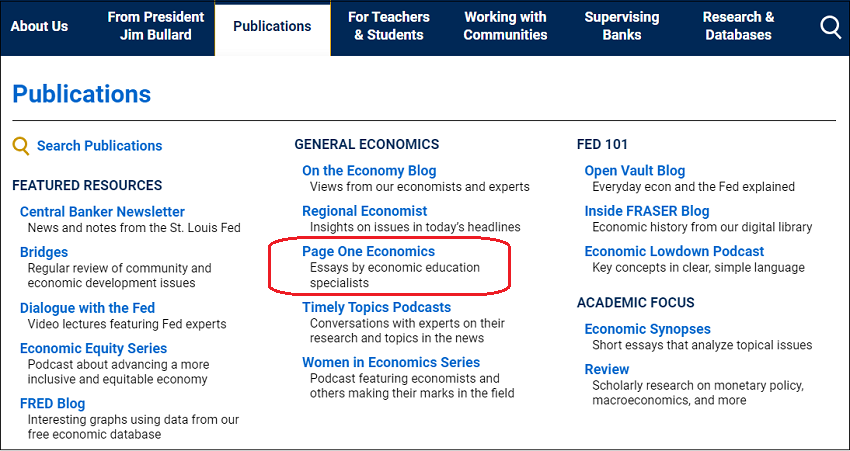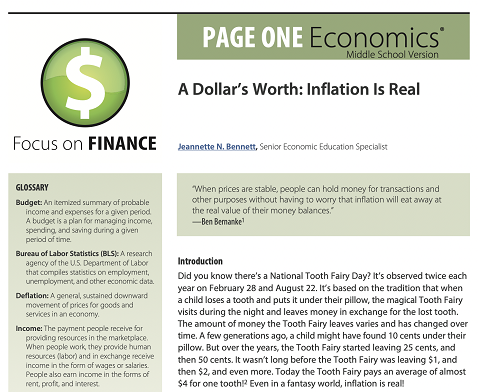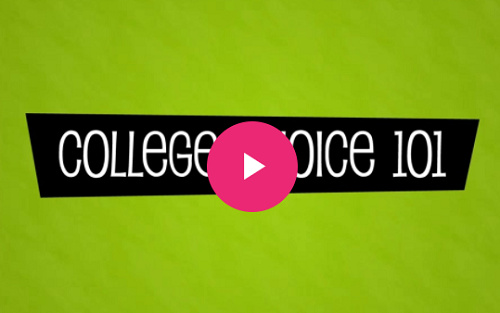- MN ABE Connect
- Archive
- A Resource for “Staying Wealthy and Wise”
 January 24, 2022
January 24, 2022
A Resource for “Staying Wealthy and Wise”
Stephanie Sommers, ACES CoordinatorOne of the things that I like about preparing for a presentation is that it motivates me to delve more deeply into a topic. As I do research and gather resources, I invariably discover treasures that are worthy of being shared.
Federal Reserve Education
In preparing for my upcoming Language and Literacy Institute session titled “Staying Healthy, Wealthy, and Wise,” as the old saying goes, I found a great resource from the Federal Reserve with a fantastic collection of materials for teaching financial literacy. The Federal Reserve Education website (https://www.federalreserveeducation.org/) is a searchable collection of materials that includes lesson plans, videos, and infographics for learners from elementary school through adult.
The website is free to access and users don’t even have to create an account. The materials align to a variety of topics and standards that are listed on the website, and I’d like to suggest that they could also be used to support the development of Critical Thinking and Navigating Systems skills from ACES/TIF (Transitions Integration Framework).
Page One Economics
One of the resources that I really like is called Page One Economics. To find it, click on FRASER LESSONS (lower right-hand corner), and then go to the Publications tab at the top of the next screen.

According to the description on the website, “Page One Economics provides a simple, short overview of a current economic event that offers students an opportunity to use close reading strategies.” (Source: https://www.stlouisfed.org/education/page-one-economics-classroom-edition/a-dollars-worth-inflation-is-real)
This resource is available as a PDF at two reading levels, so instructors can choose the Middle School Edition or the High School/College Student Edition.
 The December 2021 issue was called “A Dollar’s Worth: Inflation Is Real,” and the Middle School Edition is an 8-page document with a high-interest text, graphs and charts, a glossary of terms, a text-dependent question set, and an extension activity.
The December 2021 issue was called “A Dollar’s Worth: Inflation Is Real,” and the Middle School Edition is an 8-page document with a high-interest text, graphs and charts, a glossary of terms, a text-dependent question set, and an extension activity.
The introduction to the lesson frames inflation in terms of something that many parents can relate to, the Tooth Fairy. It explains how several generations ago, a child might have found 10 cents under their pillow after losing a tooth, while today the average payment per tooth is almost $4.00. (Note: A brief explanation of the Tooth Fairy would suffice for students unfamiliar with the concept, so that you can quickly get to the actual topic at hand.)
The text is rich with data and statistical information, and the topic of inflation is timely and relevant. It’s a great resource that could be used over several class periods to help students understand a complicated issue that is affecting everyone’s life at the moment. The issue from a year earlier, December 2020, was called “Unemployment Insurance: A Tried and True Safety Net,” and it explains the history of this important government program that has its roots in the Great Depression. The Page One Economics archives has issues going back to 2007, and some of the lessons have won awards from the National Association of Economics Educators.
Videos
If you’d rather have your students practice their listening skills, there are some great videos linked to the website. I checked out the ones from the Economic Lowdown video series. To find these videos, I had to click on the link for the Econ Lowdown Teacher Portal (lower left-hand corner), and I was taken to a companion website (https://www.econlowdown.org/).
Without creating an account, I was able to watch the Mortgage 101 video that talked about budgeting, credit scores, interest rates, and some of the pros and cons of renting and buying a home. The video introduces viewers to the PACED decision-making model, which is a framework for determining the criteria for making a decision and then evaluating how well each option meets the criteria.
 Another video in the personal finance series is called College Choice 101. This video talks about comparing costs associated with private vs. state colleges and universities, and how to successfully plan for being able to meet student loan obligations.
Another video in the personal finance series is called College Choice 101. This video talks about comparing costs associated with private vs. state colleges and universities, and how to successfully plan for being able to meet student loan obligations.
One of the things that captured my attention about both videos was the diversity of representation. The videos contain animated characters, like avatars, and I noticed a person in a wheelchair, a woman wearing a head covering, and numerous people of color.
I often hear teachers talk about wanting to find real-world resources to use in their classrooms, and the Federal Reserve Education website offers a wonderful collection of materials to choose from. This resource is being added to the ACES resource library in the Critical Thinking and Navigating Systems categories, and I encourage you to carve out a little time for doing some exploring of your own.
If the topic of Financial Literacy interests you, please check out my “Staying Healthy, Wealthy, and Wise” session at the 2022 Language & Literacy Institute. We’ll be looking at resources and lesson plans for teaching both financial and health literacy skills.
Newsletter Signup
Get MN ABE Connect—the official source for ABE events, activities, and resources!
Sign UpArticle Categories
- ABE Foundations/Staff Onboarding
- ACES/Transitions
- Adult Career Pathways
- Assessment
- CCR Standards
- Citizenship
- COVID-19
- Cultural Competency
- Digital Literacy/Northstar
- Disabilities
- Distance Learning/Education
- ELA
- Equity/Inclusion
- ESL
- HSE/Adult Diploma
- Listening
- Math/Numeracy
- Mental Health
- Minnesota ABE
- One-Room Schoolhouse/Multilevel
- Professional Development
- Program Management
- Reading
- Remote Instruction
- Science
- Social Studies
- Speaking/Conversation
- Support Services
- Teaching Strategies
- Technology
- Uncategorized
- Volunteers/Tutors
- Writing